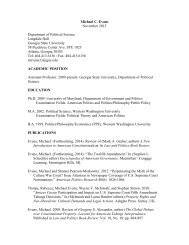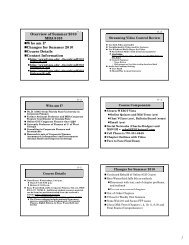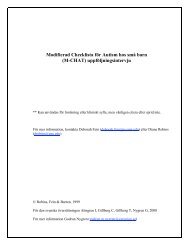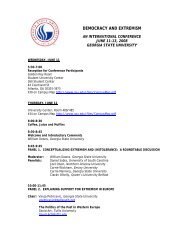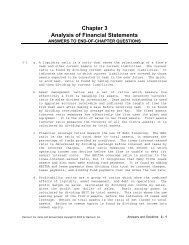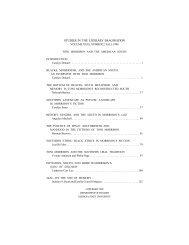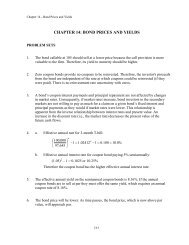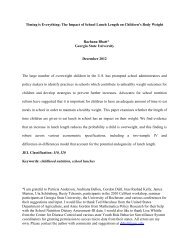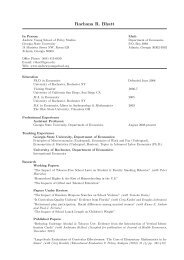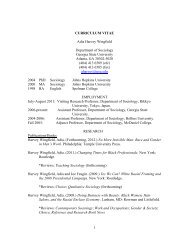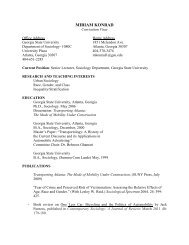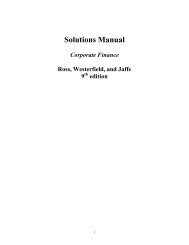HIST 4330--6920 Spring 2010 Kuhn[1] - Georgia State University
HIST 4330--6920 Spring 2010 Kuhn[1] - Georgia State University
HIST 4330--6920 Spring 2010 Kuhn[1] - Georgia State University
Create successful ePaper yourself
Turn your PDF publications into a flip-book with our unique Google optimized e-Paper software.
-<br />
ORAL <strong>HIST</strong>ORY (<strong>HIST</strong>ORY <strong>4330</strong>/<strong>6920</strong>) – <strong>Spring</strong> <strong>2010</strong><br />
Tuesdays, 5:30-8:50, 505 Classroom South<br />
Instructor: Dr. Cliff <strong>Kuhn</strong><br />
Office: 34 Peachtree St., Suite 2142<br />
Hours: Wednesday 10:00-12:00 or by appointment<br />
Phone: 404-413-6363 E-mail: ckuhn@gsu.edu<br />
The purpose of the course is to develop an appreciation of the field of oral history, its<br />
evolution, methodological concerns, and applications. In addition, students will learn<br />
about all facets of the oral history process, including interview preparation and research,<br />
equipment, interview technique, the nature and character of evidence, transcribing and<br />
editing, and legal and ethical concerns. A major component of the course will be a<br />
project based on student field work on some aspect of the theme, “The South in<br />
Transition.”<br />
Texts: Valerie Yow, Recording Oral History, 2 nd edition; Robert Perks and Alistair<br />
Thomson, eds., The Oral History Reader, 2 nd edition; Linda Shopes and Paula Hamilton,<br />
eds., Oral History and Public Memories; additional reading assignments on ERES (class<br />
password: mhm26ekfS); handouts<br />
Assignments: 1) A written assessment (3-4 pp.) of an interview conducted by the student<br />
2) A major project incorporating at least three hours of oral history<br />
interviews on a subject pertaining to the student's research interests. This<br />
project will entail: the development of a research plan; conducting the<br />
interview(s); preparation of an interview index and partial transcript; and<br />
an oral presentation and written essay (12-15 pages), both of which will<br />
include treatment of the interviews in terms of content and process.<br />
3) Class participation. Attendance is required and we will be discussing<br />
the readings in each class. In addition, for each class two students will<br />
help lead class discussion, and will prepare 5-10 discussion questions, to<br />
be handed out in class.<br />
In addition to the other assignments, graduate students in the course will be<br />
required to do write a 5-6 pp. book review of a historical work drawing heavily upon oral<br />
sources, after clearance by the instructor. Students will be judged on their ability to<br />
assess the nature and value of oral evidence as used by the author, and to evaluate the<br />
significance of that evidence to the author's thesis. For other assignments, graduate<br />
students will be subject to higher standards than undergraduates.
Grades: Undergraduates Graduate students<br />
Written assignment #1 10% Written assignment #1 10%<br />
Research design 15% Research design 10%<br />
Index and transcript 10% Index and transcript 10%<br />
Oral presentation 20% Oral presentation 15%<br />
Major paper 30% Major paper 30%<br />
Class participation 15% Class participation 15%<br />
Book review 10%<br />
Papers will be graded for coherence (organization, punctuation, grammar, spelling, etc.)<br />
as well as content. They will not be accepted after the due date!<br />
Please turn off your cell phones!<br />
Students are expected to conform to the Department of History’s guidelines concerning<br />
plagiarism and the <strong>University</strong> Policy on Academic Honesty (Section 409).<br />
An “A” grade equates to a 95, an “A-” to a 92, a “B+” to an 88, etc. An “A” reflects<br />
outstanding work, a “B” above average, a “C” average, a “D” below average, and an “F”<br />
unsatisfactory.<br />
Note: This course syllabus provides a general plan for the course; deviations may be<br />
necessary.
SCHEDULE<br />
Jan 12 Introduction/history of oral history<br />
Screening of Edward Ives, “An Oral Historian's Work”<br />
Jan 19 What is special about oral history?<br />
Yow, Ch. 1; Portelli, “What makes Oral History Different?” in Perks and<br />
Thomson; Thomson, “The Past in the Present and the Present of the Past”<br />
(electronic file); Linda Shopes, “Making Sense of Oral History,”<br />
http://historymatters.gmu.edu/mse/oral/<br />
A case study: The slave narratives<br />
James Davidson and Mark Lytle, “The View from the Bottom Rail: Oral<br />
History and The Freedmen’s Point of View,” in After the Fact: The Art of<br />
Historical Detection, 5 th edition, pp. 177-209; John Blassingame, Slave<br />
Testimony, pp. xlii-lxiii, both on ERES; selected interviews in George<br />
Rawick, ed., The American Slave:A Composite Biography, in stacks<br />
Jan 26 Interview preparation and technique<br />
Yow, Chs. 3-4; Introduction to Part II and “Studs Terkel, with Tony<br />
Parker,” in Perks and Thomson<br />
Bring recorders<br />
Feb 2 The relationship between interviewer and narrator<br />
Yow, Ch. 6; Yow, “‘Do I Like Them Too Much?’,” Bozzoli, “Interviewing the<br />
Women of Phokeng,” both in Perks and Thomson; Van Boeschoten,<br />
“Public Memory as an Arena for Contested Meanings,” in Shopes and<br />
Hamilton; Karen Olson and Linda Shopes, “Crossing Boundaries, Building<br />
Bridges: Doing Oral History Among Working-Class Men and Women, in<br />
Daphne Patai and Sherna Berger Gluck, Women's Words, pp. 189-204 and<br />
Alessandro Portelli, “Research as an Experiment in Equality,” in Portelli,<br />
The Death of Luigi Trastulli, pp. 29-44 both on ERES<br />
Feb 9 The Rural South<br />
LuAnn Jones, “Voices of Southern Agricultural History,” in International<br />
Annual of Oral History, 1990, pp. 135-44; Theodore Rosengarten, All<br />
God’s Dangers, pp. xiii-xxiv, 3-57, both on ERES; Jones, “‘Mama Learned<br />
Us to Work’: An Oral History of Virgie St. John Richmond,” in OHR 17<br />
(Fall 1989), pp. 63-90, available through JSTOR.
Written assignment #1 due<br />
Discussion/playback of interviews<br />
Feb 16 Life in the Jim Crow South<br />
Scott Ellsworth, “The Segregation of Memory” in Ellsworth, Death in a<br />
Promised Land, pp. 98-107 (ERES); selections from “Remembering Jim<br />
Crow” and “The Rise and Fall of Jim Crow” web sites<br />
Civil rights<br />
Youth of the Rural Organizing and Cultural Center, Minds Stayed on<br />
Freedom, pp. 1-34, 46-55, 117-130, 143-157; Charles M. Payne, “The Social<br />
Construction of History,” in Payne, I’ve Got the Light of Freedom, pp. 413-<br />
441 (ERES)<br />
Playing and discussion of “Will the Circle be Unbroken” excerpts<br />
Feb 23 Southern Politics<br />
Clifford <strong>Kuhn</strong>, Harlon Joye and Bernard West, Living Atlanta: An Oral<br />
History of the City, 1914-1948, pp. 311-49; Jennifer E. Brooks, “Winning<br />
the Peace: <strong>Georgia</strong> Veterans and the Struggle to Define the Political Legacy<br />
of World War II,” Journal of Southern History LXVI (August 2000), pp.<br />
565-604; Alexander Heard, “Interviewing Southern Politicians,” American<br />
Political Science Review, XLIV (December, 1950), pp. 886-892 (all on<br />
ERES); Clifford <strong>Kuhn</strong>, “‘There's a Footnote to History’: Memory and the<br />
History of Martin Luther King's October 1960 Arrest and Its Aftermath,”<br />
Journal of American History 84 (Fall 1997), pp. 583-595; Ronald E.<br />
Marcello, “Interviewing Contemporary Texas Legislators: An Atypical<br />
Approach,” Public Historian, 7 (Fall 1985), pp. 53-64, both on JSTOR<br />
Mar 2 History and Memory: a case study – war stories<br />
Yow, Ch. 2; Intro to Part III, Allison, “Remembering a Vietnam War<br />
Firefight,” Roseman, “Surviving Memory,” and Thomson, “Anzac<br />
Memories,” all in Perks and Thomson; Dubrow, “Contested Places in<br />
Public Memory,” Jefferson, “Interfaced Memory,” and Salvatici, “Public<br />
Memory, Gender, and National Identity in Postwar Kosovo,” all in Shopes<br />
and Hamilton<br />
Research design due<br />
Mar 9 <strong>Spring</strong> break<br />
Mar 16 Legal and ethical issues
Yow, Ch. 5; Blee, “Evidence, Empathy and Ethics: Lessons from Oral<br />
Histories of the Klan,” in Perks and Thomson; Linda Shopes, “Legal and<br />
Ethical Issues in Oral History” (electronic file); selections from John<br />
Neuenschwander, “Oral History and the Law”; Oral History Association<br />
Evaluation Guidelines and Principles and Best Practices (available through<br />
oralhistory.org)<br />
Mar 23 After the interview: processing and transcription<br />
Good, “Voice, Ear, and Text,” in Perks and Thomson; Michael Frisch,<br />
“Preparing Interview Transcripts for Documentary Publication: A Line-by-<br />
Line Illustration of the Editing Process,” in Frisch, A Shared Authority, pp.<br />
81-146 (ERES); Yow, Ch. 11<br />
After the interview: interpreting oral evidence<br />
Yow, Ch. 10; Lummis, “Structure and Validity in Oral Evidence,” Borland,<br />
“‘That’s Not What I Said’,” in Perks and Thomson; Neufeld, “Parks<br />
Canada, the Commemoration of Canada, and Northern Aboriginal Oral<br />
History,” in Shopes and Hamilton.<br />
Index and transcript due<br />
Mar 30 Oral history and family history<br />
Yow, Ch. 9; Finnegan, “Family Myths,” in Perks and Thomson<br />
Oral history and community history<br />
Yow, Ch. 7; Shopes, “Oral History and the Study of Communities,” in Perks<br />
and Thomson; Field, “Imagining Communities: Memory, Loss and<br />
Resilience on Post-Apartheid South Africa,” and Blackburn, “History from<br />
Above: The Use of Oral History in Shaping Collective Memory in<br />
Singapore,” both in Shopes and Hamilton; Shopes, “Oral History and<br />
Community Involvement: The Baltimore Neighborhood Heritage Project,”<br />
in Benson, Brier and Rosenzweig, eds., Presenting the Past, pp. 249-266<br />
(ERES)<br />
Apr 6 Oral history and media: radio and film<br />
David Dunaway, “Radio and the Public Use of Oral History,” in Dunaway<br />
and Baum, Oral History: An Interdisciplinary Anthology, pp. 333-346<br />
(ERES); Introduction to Part IV, Hardy, “Authoring in Sound,” and Kerr,
“We Know What the Problem is,” both in Perks and Thomson<br />
Selections from “Living Atlanta” and other radio documentaries<br />
Sipe, “The Future of Oral History and Moving Images,” in Perks and<br />
Thomson<br />
Selections from oral history-based films<br />
Apr 13 Oral history and media: museums and digital media<br />
<strong>Kuhn</strong>, “Oral History: Media, Message, and Meaning” (electronic file);<br />
Green, “The Exhibition that Speaks for Itself” and Butler and Miller,<br />
“Linked,” both in Perks and Thomson; Thomas, “Private Memory in a<br />
Public Space” and Bozic-Vrbancic, “”Scars in the Ground,’” both in Shopes<br />
and Hamilton<br />
Michael Frisch, “Oral History and the Digital Revolution,” in Perks and<br />
Thomson; Charles Hardy and Alessandro Portelli, “I Can Almost See the<br />
Lights of Home,” Journal of Multi-Media History 2 (1999),
www.albany.edu/jmmh/<br />
examples from oral history web sites<br />
Graduate student book reviews due<br />
Apr 20 Student presentations<br />
Apr 27 Student presentations/final papers due


![HIST 4330--6920 Spring 2010 Kuhn[1] - Georgia State University](https://img.yumpu.com/15992617/1/500x640/hist-4330-6920-spring-2010-kuhn1-georgia-state-university.jpg)
